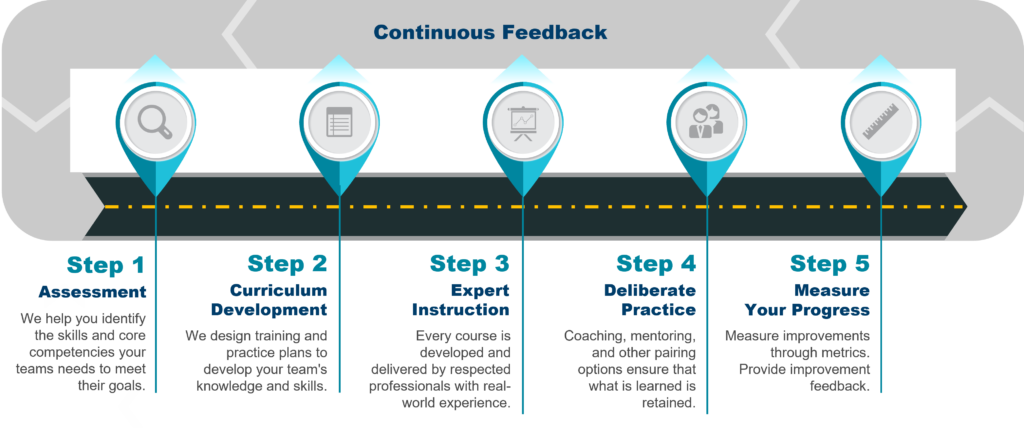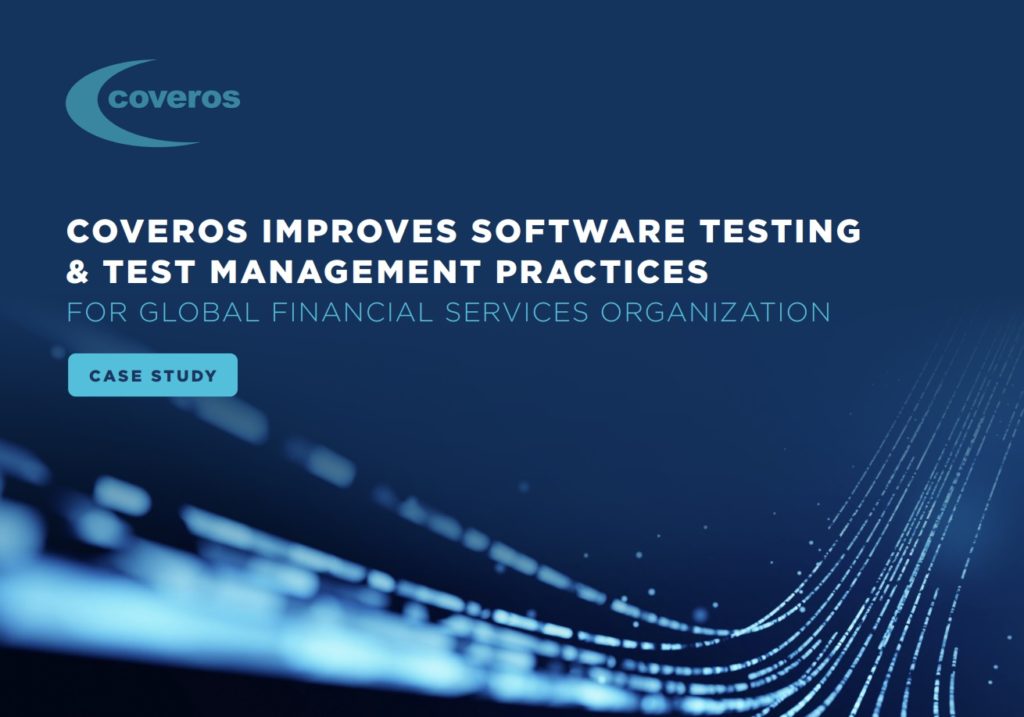Get ready to hear something obvious: We live in uncertain times, especially in the software community.
The emergence of AI and other disruptive technologies. Economic unpredictability. A shifting industry landscape and job market. It’s more important than ever for software organizations to stay relevant and innovative.
So how can your team stay ahead of this rapidly shifting curve? At Coveros, we’ve seen two critical trends from organizations we’re working with:
- Leaders want to ensure their team members have the latest and greatest skills to stay competitive.
- Organizations are increasingly seeing the value of training to enhance recruitment and retention efforts.
The bottom line: In order to compete now and in the future, organizations need to develop a comprehensive and effective learning strategy for their entire organization and individual team members.
Our team helps build customized learning strategies for many forward-thinking organizations each year. We’ve developed a proven approach to understand organizations’ learning needs, identify key areas of learning, and deliver and reinforce that learning. Here’s how we do it.

Step 1: Assess your current and future learning needs
Training simply for training’s sake never works. To build a learning strategy that sticks, you must first assess critical needs and gaps. This involves evaluating the existing skill sets of your team, identifying gaps, and understanding the specific requirements of your projects – both current and future ones.
At Coveros, our assessment approach includes one-on-one interviews with leaders and team members to understand your current skills, along with analysis of any relevant strategy documents and team skills. We also gather an organization-wide perspective through a skills assessment survey that asks team members to identify their current and needed skills.
Certification: Setting the Standard
One key aspect of needs assessment is determining if any certifications are necessary for your team members to meet industry standards and client expectations.
Certifications provide a standardized measure of competence and are often crucial in the software industry. For example, certifications in Agile methodologies, DevOps practices, testing approaches, or specific programming languages can validate the skills of your team and enhance the expertise and credibility of your company. We also work with organizations focusing on implementing new tools or workflows. For instance, we’ve partnered with GitHub to deliver critical training and consulting services for organizations working to implement or enhance their use of tools like GitHub Advanced Security, GitHub Copilot, and more.
Prioritize certifications that align with your project requirements and industry trends, ensuring that your team is equipped with the latest knowledge and best practices.
Step 2: Develop a quality curriculum
Once you’ve identified the skills and certifications needed, the next step is choosing the right training classes.
Consider the following critical topic areas that are pivotal for modern software development:
1. Testing: Ensuring Quality Assurance
Testing is a cornerstone of software development, and comprehensive training in testing methodologies is essential. From automated testing to performance testing, invest in classes that cover a spectrum of testing practices.
2. DevOps: Streamlining Development and Operations
DevOps practices aim to enhance collaboration between development and operations teams, fostering a culture of continuous integration and continuous delivery (CI/CD). Training in DevOps principles equips your team with the knowledge to automate workflows, improve efficiency, and deliver high-quality software faster.
3. Agile: Embracing Flexibility and Collaboration
Agile methodologies have revolutionized project management in the software industry. Training in Agile principles ensures that your team can adapt to changing requirements, collaborate effectively, and deliver incremental value to clients.
4. AI: Navigating the World of Artificial Intelligence
As AI becomes increasingly integral to software development, training in AI concepts and practices is crucial. Classes that cover machine learning algorithms, natural language processing, and AI model deployment empower your team to integrate AI solutions seamlessly into your projects. Stay abreast of industry advancements and invest in training that aligns with the evolving landscape of AI technologies.
5. Application Security: Prioritizing Protection
In an era of heightened cybersecurity concerns, training your team in application security is non-negotiable. Classes on secure coding practices, vulnerability assessments, and threat modeling ensure that your software is resilient to cyber threats.
6. Mastery of critical tools
Depending on your strategic focus, your team will most likely need skills in crucial tools or platforms. For instance, GitHub is a ubiquitous platform for version control, collaboration, and code management. As a premier partner of GitHub, Coveros provides exclusive training in GitHub’s suite of tools.
Once you’ve identified your prioritized classes, work with a training expert to build a calendar of training that supports your team’s schedule.
Step 3: Deliver expert instruction
Now that you have your learning plan in place, it’s time to deliver quality, real-world training led by experts in their respective fields. We’ve found that effective learning happens in courses with a combination of expert-led instruction and real-world examples and exercises.
Providing varied learning environments is also another important piece of the puzzle. At Coveros, we offer several learning environments based on an organization’s needs:
- In-person, private team training
- Live, virtual private team training
- In-person public training at software industry conferences
- Live, virtual public training
While all training environments can be effective, we’ve found that the most effective learning environment for teams is through in-person, private team training. This learning approach provides the best opportunity for bonding and problem-solving among teams and reduces the common distractions that can crop up during virtual training.
Step 4: Reinforce learning with deliberate practice
At Coveros, our philosophy is learning = training + practice. While quality instruction is vital, learning is truly only solidified with regular practice and ongoing experience. There are several approaches to ensuring learning retention.
1. Ongoing Coaching: Reinforcing and Evolving Skills
Ongoing coaching is essential to reinforce skills, address challenges, and adapt to emerging trends. Whether it’s hands-on support or coaching from experts on specific projects or “office hour”-style meetings, providing your team with experts who can help answer questions and provide their experience is a crucial way to ensure team members truly learn. We’ve seen the most success with teams who have paired our private team classroom training with expert coaching.
2. Mentorship Programs: Fostering Knowledge Transfer
Establish mentorship programs within your company to facilitate knowledge transfer. Experienced team members can guide and mentor less experienced ones, sharing practical insights and best practices. This not only accelerates skill development but also fosters a culture of continuous learning within your organization.
3. Learning Resources: Curating a Knowledge Hub
Create a centralized knowledge hub with access to relevant learning resources. This could include documentation, tutorials, and curated content that allows your team to explore new concepts and technologies at their own pace. Encourage a self-directed learning culture within your organization.
Step 5: Measure progress and continue learning
A crucial aspect of any training strategy is establishing measures of progress to assess how effectively students are learning.
How many team members achieved strategic certifications? Have important development and testing processes become more efficient post-training? Has the quality of your product improved? These are all critical questions you should be asking yourself to assess your learning strategy.
Be sure to identify key analytics before implementing your training strategy so you can assess the effectiveness of learning on those measures. Assessing your team’s learning can also be done through qualitative approaches like post-training interviews.
Use these measures to not only assess your current training approach but also identify new areas of focus and strategies for further learning.
Learning is an ongoing and adaptive process. While the phases of learning outlined here are important, how exactly you implement these phases (and when) will vary based on your organization’s specific needs.
Looking to build a learning strategy that sticks in 2024?
We’d love to chat about your current challenges and opportunities and how our unique learning approach can help. Simply click the button below to set up an initial chat with one of our learning experts.




